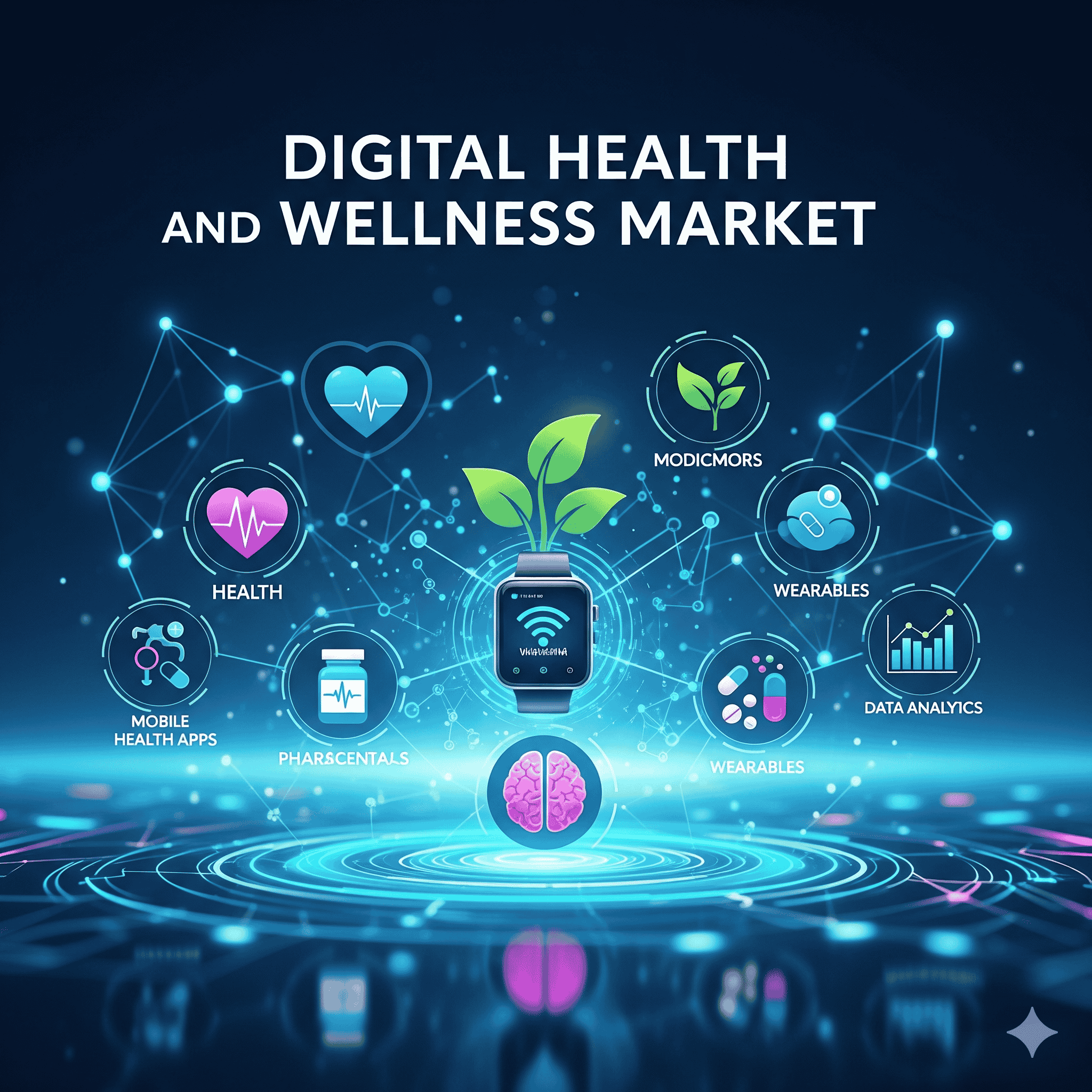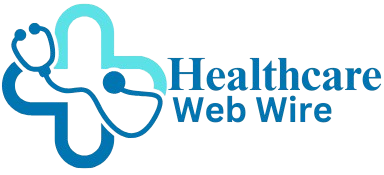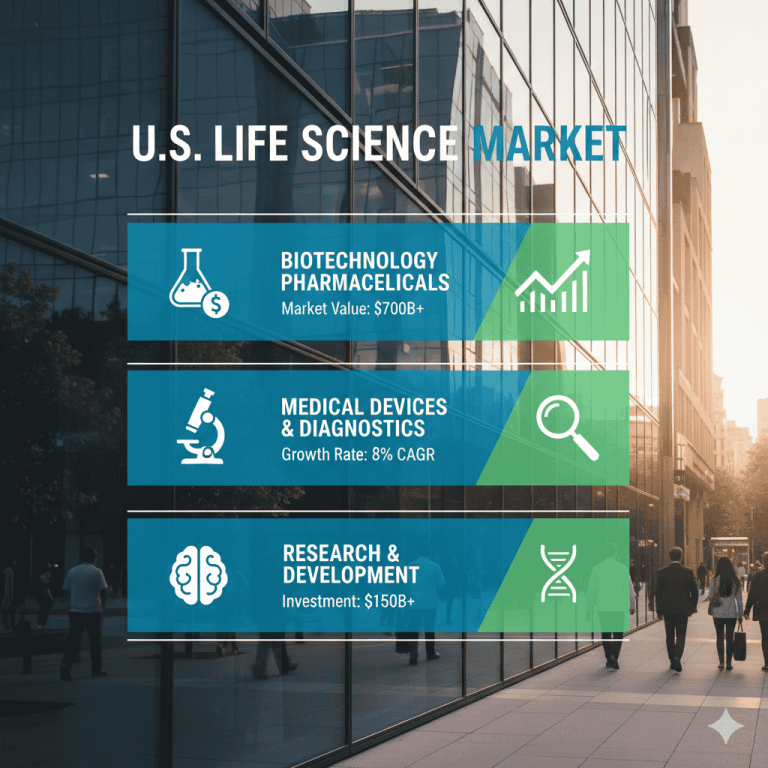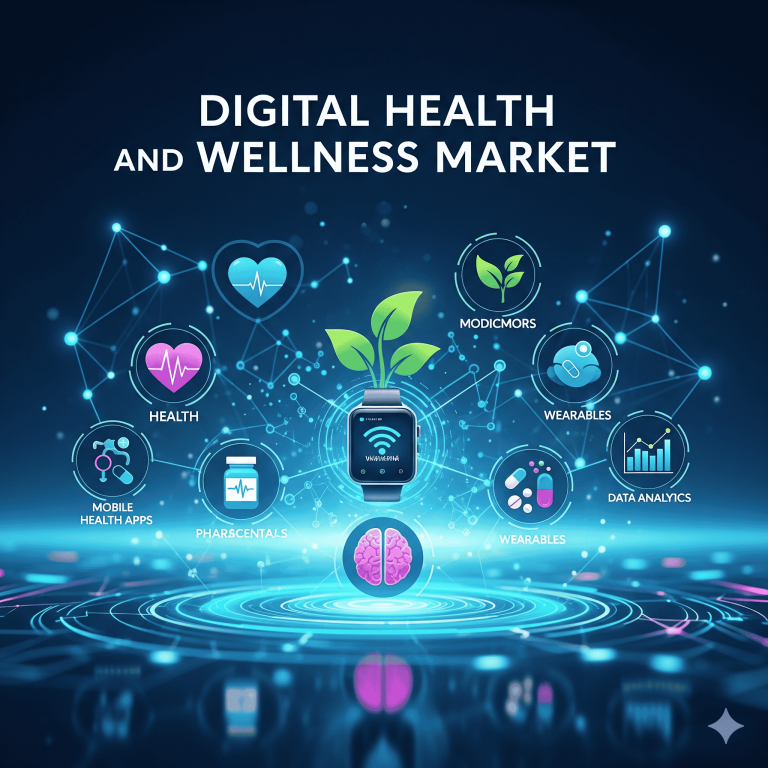
The global digital health and wellness market is projected to expand from US$ 498.99 billion in 2024 to US$ 3,568.11 billion by 2034, growing at a CAGR of 21.92%, driven by technological advancements, AI integration, wearable adoption, rising consumer awareness, and government initiatives promoting personalized, preventive, and chronic health management solutions.

Download the free sample and get the complete insights and forecasts report on this market @ https://www.towardshealthcare.com/download-sample/6130
Market Size
2024 Market Size: USD 498.99 Billion
●Dominated by software & mobile apps due to increasing use of mobile health applications for fitness, mental wellness, nutrition, and chronic condition management.
●Early adoption concentrated in North America due to technological infrastructure and high smartphone penetration.
2025 Market Size: USD 607.06 Billion
●Growth driven by wearables and IoT integration in health monitoring.
●Expansion aided by corporate wellness programs and direct-to-consumer apps.
2034 Projected Market Size: USD 3,568.11 Billion
●High CAGR (21.92%) indicates rapid adoption across Asia Pacific, Europe, and Latin America.
●AI-powered personalization and chronic disease monitoring are expected to dominate revenue growth.
Key Growth Segments:
●Software & Mobile Apps: Fitness, nutrition, sleep, stress, and mental wellness applications.
●Devices & Wearables: Smartwatches, rings, sensors, and wearable patches enabling real-time health monitoring.
●Services: Telehealth coaching, digital therapy programs, and data analytics solutions.
Market Trends
Rising Digitalization & Mobile Health Adoption
●Subpoint 1: Growing smartphone penetration globally enables access to fitness and wellness apps.
●Subpoint 2: Mobile apps provide real-time tracking of vitals, nutrition, sleep, and stress levels.
●Subpoint 3: Users increasingly prefer personalized, AI-driven health insights over generic programs.
Influence of Social Media & Fitness Culture
●Fitness influencers drive awareness about wellness apps and devices.
●Social platforms provide community motivation and accountability, enhancing user engagement.
●Gamification strategies encourage consistency and app retention.
Telemedicine Expansion
Remote monitoring allows continuous care for chronic disease patients.
Integration with EHR/EMR systems streamlines data sharing and patient management.
Enables reducing hospital visits, particularly in rural and underserved areas.
AI & ML Integration
●AI personalizes recommendations for nutrition, exercise, sleep, and mental wellness.
●Predictive algorithms identify high-risk users for lifestyle or chronic condition intervention.
●Machine learning models help optimize app engagement and behavioral nudges.
Wearables & IoT Sensors
●Smart devices continuously collect data on heart rate, sleep, activity, blood oxygen, and stress.
●IoT-enabled integration with mobile apps improves real-time health analysis.
●Data aggregation enhances population health insights for research and insurance applications.
Mental Wellness Focus
●Stress, mindfulness, and mental wellness apps address globally rising anxiety and depression rates.
●Digital therapy and mindfulness programs reduce psychological burden on healthcare systems.
●AI-based sentiment analysis detects mood shifts and provides timely interventions.
Government Initiatives
●India: Delhi’s HIMS and digital platform projects streamline patient data, OPD scheduling, and billing.
●Canada: Bill C-72 ensures secure access to patient health information.
●Germany: EHDS (European Health Data Space) standardizes electronic health record use across Europe.
Consumer Empowerment & Preventive Health
●Apps encourage self-management of chronic conditions.
●Personalized preventive recommendations reduce long-term healthcare costs.
●Integration with wearable devices provides real-time insights for lifestyle optimization.
Corporate Wellness Programs
●Companies adopt digital platforms to monitor employee wellness, mental health, and productivity.
●Program types: meditation apps, virtual counseling, gym memberships, and activity challenges.
●Helps reduce burnout and healthcare costs, improving employee satisfaction.
Urbanization & Rising Disposable Income
●Urban populations are increasingly conscious about health and wellness trends.
●Growth in premium wellness subscriptions and wearable adoption.
●Affluence enables early adoption of AI-based health tools and connected devices.
AI Impact / Role in Digital Health and Wellness
Personalized Health Recommendations
●AI analyzes user data (sleep, nutrition, activity) for customized fitness plans.
●Adapts recommendations based on progress and lifestyle changes.
Predictive Analytics for Risk Detection
●ML models identify individuals at risk for chronic diseases or mental health issues.
●Enables proactive interventions to prevent worsening conditions.
Remote Patient Monitoring (RPM)
●AI interprets real-time wearable data to alert patients and healthcare providers.
●Reduces hospitalizations and improves chronic disease management.
Virtual Coaching & Behavioral Change
●AI chatbots and virtual trainers provide reminders, motivation, and personalized routines.
●Reinforces habit formation through gamification and analytics.
Mental Health Assessment & Therapy
●NLP analyzes user input for mood and stress patterns.
●Offers CBT, meditation, and mindfulness recommendations in real-time.
Population Health Insights
●AI aggregates anonymized data for research and public health interventions.
●Identifies trends in sleep, activity, nutrition, and disease prevalence.
Workflow Automation for Providers
●AI automates appointment scheduling, reminders, and report generation.
●Frees up provider time for patient engagement.
Enhanced User Engagement
●Predictive notifications and adaptive goal setting improve adherence to wellness programs.
●Increases retention rates for apps and devices.
Integration with IoT Devices
●AI analyzes sensor data for heart rate variability, activity patterns, and sleep stages.
●Delivers actionable insights directly to users’ devices.
Chronic Disease Management
●AI assists in self-management of diabetes, hypertension, sleep disorders, and cardiac conditions.
●Provides alerts for medication adherence and lifestyle adjustments.
Top Companies

Apple (Health, Fitness+)
●Ecosystem of wearables, apps, and personalized fitness coaching.
●Strength: Brand recognition, device integration, AI-driven insights.
Google / Fitbit
●Wearables, fitness apps, and AI analytics for activity and sleep tracking.
●Strength: Advanced AI analytics and global consumer reach.
Samsung Health
●Smartwatches and integrated wellness apps.
●Strength: Hardware-software ecosystem and global presence.
Garmin
●Fitness trackers and GPS-enabled wearables.
●Strength: Precision sensors and endurance-focused tracking.
Huawei Health
●AI-driven health monitoring apps and wearables.
●Strength: Emerging market penetration, AI-enabled insights.
Withings
●Smart scales, BP monitors, sleep tracking devices.
●Strength: Interoperable health devices with accurate metrics.
Oura
●Smart ring for sleep, activity, and recovery tracking.
●Strength: High precision sleep tracking and AI analytics for wellness.
WHOOP
●Subscription-based performance and recovery wearables.
●Strength: Elite athlete adoption, advanced health analytics.
Peloton
●Interactive fitness equipment and streaming platform.
●Strength: Strong community engagement and motivation through gamification.
Strava
●Social network for athletes with activity tracking.
●Strength: Community motivation, gamification, and competitive features.
Latest Announcements
●Oura (August 2025): Released two new products focused on supporting women through key life stages.
●Emphasis: Science-backed, empathetic, privacy-focused solutions.
Recent Developments
January 2025:
●Allumia Ventures spun off from Providence.
●VitVio received $2M pre-seed funding for wearable health tech.
●Qualified Health secured $30M to develop genAI in healthcare.
August 2024:
●Create Health Ventures launched its $21M fund to support early-stage digital health startups.
Segments Covered
By Component
1. Software & Mobile Apps
●Overview: Digital health apps form the backbone of the market, offering a wide range of functionalities for fitness, nutrition, sleep, mental wellness, and chronic condition management.
Subpoints & Explanation:
●Fitness Apps: Track workouts, steps, calories, and offer AI-generated personalized exercise plans. Integration with wearables enhances accuracy.
●Sleep & Stress Apps: Monitor sleep patterns, stress levels, and recovery using AI/ML analytics; provide recommendations like guided meditation or sleep routines.
●Nutrition & Weight Management Apps: Track calorie intake, macronutrients, hydration, and offer diet suggestions based on goals. AI can adapt diet plans based on progress.
●Mental Wellness Apps: Offer mindfulness, CBT exercises, journaling, and meditation routines; AI detects mood changes and tailors content.
●Chronic Condition Apps: For diabetes, hypertension, or heart disease; track vitals, provide alerts, medication reminders, and integrate with RPM devices.
●Importance: These apps empower individuals to self-manage their health, provide real-time feedback, and connect users with healthcare providers for preventive and therapeutic purposes.
2. Devices & Wearables
●Overview: Physical devices that collect biometric and lifestyle data, bridging the gap between digital solutions and real-world health monitoring.
●Subpoints & Explanation:
●Fitness Bands & Smartwatches: Monitor activity, heart rate, sleep quality, oxygen levels; integrate with apps for AI-powered insights.
●Smart Rings & Patches: Provide continuous monitoring of HRV, temperature, and recovery metrics; discreet and wearable 24/7.
●Smart Scales & BP Cuffs: Capture weight, body composition, blood pressure; data synced with mobile apps for trend analysis.
●Integration with IoT Platforms: Enables predictive analytics, real-time alerts, and chronic disease management.
●Importance: These devices enable continuous health monitoring, early detection of anomalies, and collection of actionable data for AI analytics.
3. Services
●Overview: Services complement hardware and software by offering personalized guidance, analytics, and remote support.
Subpoints & Explanation:
●Coaching & Tele-Wellness Programs: Live or AI-driven coaching for fitness, nutrition, or stress management; adapts to user progress.
●Data Analytics & Reporting: Generates personalized health insights, population health trends, and predictive models.
●Behavioral Change Support: Programs integrate habit-forming techniques, reminders, and gamification to improve adherence.
●Remote Patient Engagement: Enables interaction between patients and providers without in-person visits, critical for chronic conditions.
●Importance: Services enhance adoption, engagement, and long-term health outcomes by guiding users through actionable steps.
By Solution Category
1. Fitness & Activity Tracking
●Monitors steps, exercise routines, calories, heart rate; provides AI-driven recommendations.
●Popular among health-conscious users and athletes; supports goal-setting and gamification.
2. Sleep & Recovery
●Tracks sleep stages, quality, and recovery metrics.
●AI-driven insights optimize routines and improve performance, reduce fatigue, and support mental wellness.
3. Stress, Mindfulness & Mental Wellness
●Offers guided meditation, CBT, relaxation techniques, and mood tracking.
●Increasingly important due to global rise in anxiety and depression.
4. Nutrition & Weight Management
●Tracks diet, hydration, macronutrient intake, and provides AI-adjusted meal plans.
●Integrates with wearables for calorie burn vs. intake analysis.
5. Women Health & Fertility
●Tracks menstrual cycles, fertility windows, pregnancy, and menopause.
●AI predicts cycles, provides health insights, and integrates with personalized coaching.
6. Chronic Disease & Remote Monitoring (RPM)
●Manages conditions like diabetes, hypertension, heart disease.
●Integrates wearables, apps, and AI to track vitals, send alerts, and support telemedicine.
7. Medication & Adherence
●Provides reminders, dosing instructions, and monitoring adherence.
●AI can detect missed doses and alert patients or caregivers.
8. Corporate Wellness Programs
●Employee wellness platforms integrating fitness, mental health, and lifestyle management.
●Encourages engagement via gamification, challenges, and corporate incentives.
9. Healthy Aging & Longevity
●Focus on age-related health monitoring, fall detection, mobility tracking, and cognitive wellness.
●AI and wearables enable early intervention and improved quality of life.
By Technology
1. IoT & Wearable Sensor Platforms
●Collect real-time biometric and activity data.
●Enable integration of devices with mobile apps and cloud platforms for analysis.
2. AI/ML Analytics & Personalization
●Processes collected data to offer predictive insights, recommendations, and health coaching.
●Supports chronic disease management, preventive care, and mental wellness.
3. Cloud & Edge Computing
●Cloud allows large-scale storage and sharing of health data.
●Edge computing ensures low-latency processing on devices for real-time decision-making.
4. Interoperability & APIs (FHIR)
●Enables seamless integration of apps, devices, and healthcare systems.
●Facilitates data sharing between patients, providers, and research institutions.
5. AR/VR & Digital Coaching Interfaces
●Immersive experiences for fitness, mindfulness, and rehabilitation.
●Enhances user engagement and motivation through interactive learning.
6. Data Privacy & Security Tools
●Encryption, secure data transfer, and user consent management.
●Critical for compliance with HIPAA, GDPR, and national regulations.
Top 5 FAQs
Q1: What is the size of the digital health and wellness market in 2025?
A: USD 607.06 Billion, driven by wearable adoption and AI-enabled mobile apps.
Q2: Which region dominates the market?
A: North America dominates due to high digital adoption, government initiatives, and funding support.
Q3: Which component is growing fastest?
A: Devices & Wearables, due to IoT integration and health monitoring demand.
Q4: What solution category is experiencing fastest growth?
A: Stress, mindfulness, and mental wellness apps, due to rising mental health concerns.
Q5: How does AI influence the market?
A: Through personalized recommendations, predictive analytics, chronic disease management, virtual coaching, and real-time patient monitoring.
Access our exclusive, data-rich dashboard dedicated to the healthcare market – built specifically for decision-makers, strategists, and industry leaders. The dashboard features comprehensive statistical data, segment-wise market breakdowns, regional performance shares, detailed company profiles, annual updates, and much more. From market sizing to competitive intelligence, this powerful tool is one-stop solution to your gateway.
Access the Dashboard: https://www.towardshealthcare.com/access-dashboard
Immediate Delivery Available | Buy This Premium Research @ https://www.towardshealthcare.com/price/6130
Become a valued research partner with us – https://www.towardshealthcare.com/schedule-meeting
You can place an order or ask any questions, please feel free to contact us at sales@towardshealthcare.com
Powering Healthcare Leaders with Real-Time Insights: https://www.towardshealthcare.com/healthcare-intelligence-platform
Europe Region – +44 778 256 0738
North America Region – +1 8044 4193 44
APAC Region: +91 9356 9282 04
Web: https://www.towardshealthcare.com
Find us on social platforms: LinkedIn | Twitter | Instagram | Medium | Pinterest




